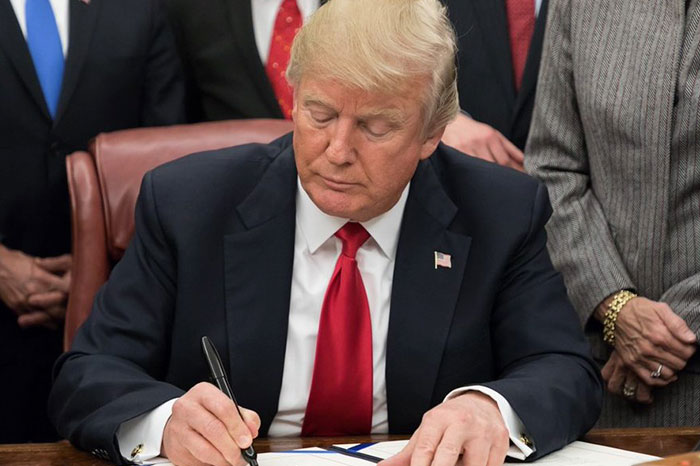File Photos
By Michael V. Cusenza
President Donald Trump this week detailed his new plan to, as he put it, confront the driving forces behind America’s opioid crisis.
The Initiative to Stop Opioid Abuse and Reduce Drug Supply and Demand, according to the White House, will address factors fueling the epidemic, including over-prescription, illicit drug supplies, and insufficient access to evidence-based treatment, primary prevention, and recovery support services.
Trump’s initiative, which he outlined on Monday in New Hampshire, is built on three pillars: reduce demand and over-prescription; cut off the supply of illicit drugs; help those struggling with addiction.
Reduce Demand and Over-Prescription
Launch a nationwide evidence-based campaign to raise public awareness about the dangers of prescription and illicit opioid use, as well as other drug use.
Support research and development efforts for innovative technologies and additional therapies designed to prevent addiction and decrease the use of opioids in pain management, including supporting research and development for a vaccine to prevent opioid addiction and non-addictive pain management options.
Reduce the over-prescription of opioids which has the potential to lead Americans down a path to addiction or facilitate diversion to illicit use.
Implement a safer prescribing plan to achieve the following objectives: cut nationwide opioid prescription fills by one-third within three years; ensure that 75 percent of opioid prescriptions reimbursed by federal healthcare programs are issued using best practices within three years, and 95 percent within five years; ensure that at least half of all federally-employed healthcare providers adopt best practices for opioid prescribing within two years, with all of them doing so within five years; and leverage federal funding opportunities related to opioids to ensure that States transition to a nationally interoperable Prescription Drug Monitoring Program network.
Cut off the Supply of Illicit Drugs
Secure land borders, ports of entry, and water ways against illegal smuggling.
Require advance electronic data for 90 percent of all international mail shipments (with goods) and consignment shipments within three years, in order for the Department of Homeland Security to flag high-risk shipments.
Identify and inspect high-risk shipments leveraging advanced screening technologies and by using drug-detecting canines.
Test and identify suspicious substances in high-risk international packages to quickly detect and remove known and emerging illicit drugs before they can cause harm.
Engage with China and expand cooperation with Mexico to reduce supplies of heroin, other illicit opioids, and precursor chemicals.
Advance the Department of Justice Prescription Interdiction and Litigation Task Force to fight the prescription opioid crisis. According to the president, the PIL Task Force will: expand the DOJ Opioid Fraud and Abuse Detection Unit’s efforts to prosecute corrupt or criminally negligent doctors, pharmacies, and distributors; aggressively deploy appropriate criminal and civil actions to hold opioid manufacturers accountable for any unlawful practices.
Shut down illicit opioid sales conducted online and seize any related assets by scaling up internet enforcement efforts under DOJ’s new Joint Criminal Opioid Darknet Enforcement team.
Strengthen criminal penalties for dealing and trafficking in fentanyl and other opioids: DOJ will seek the death penalty against drug traffickers, where appropriate under current law; Trump also calls on Congress to pass legislation that reduces the threshold amount of drugs needed to invoke mandatory minimum sentences for drug traffickers who knowingly distribute certain illicit opioids that are lethal in trace amounts.
Help Those Struggling with Addiction
Work to ensure first responders are supplied with naloxone, a lifesaving medication used to reverse overdoses.
Leverage federal funding opportunities to State and local jurisdictions to incentivize and improve nationwide overdose tracking systems that will help resources to be rapidly deployed to hard-hit areas.
Expand access to evidence-based addiction treatment in every State, particularly medication-assisted treatment for opioid addiction.
Seek legislative changes to the law prohibiting Medicaid from reimbursing residential treatment at certain facilities with more than 16 beds; in the meantime, continue approving State Medicaid demonstration projects that waive these barriers to inpatient treatment.
Provide on-demand, evidence-based addiction treatment to service members, veterans and their families eligible for healthcare through the Departments of Defense or Veterans Affairs.
Leverage opportunities in the criminal justice system to identify and treat offenders struggling with addiction.
Trump is no stranger to substance abuse and addiction. He has invoked the name of his older brother Fred and Fred’s struggles with alcohol, which eventually claimed his life, when discussing the United States’ drug crisis. With that in mind, Trump on Monday also unveiled CrisisNextDoor.gov, a Web portal where anyone can share their own stories about the dangers of opioid addiction.
“I learned because of Fred. I learned. And that’s what I think is so important,” Trump said. “It is time to liberate our communities from this scourge of drug addiction.”

